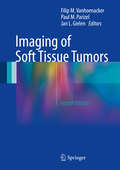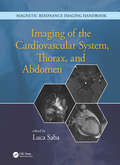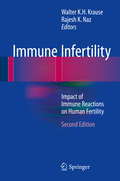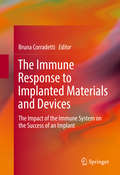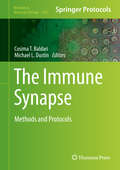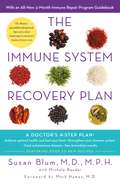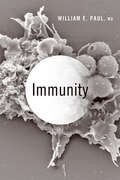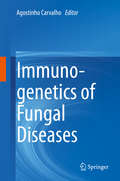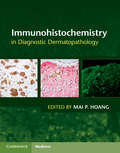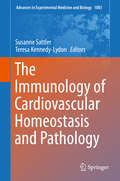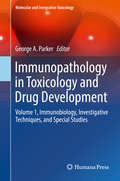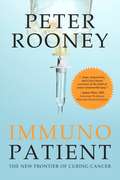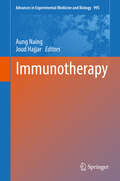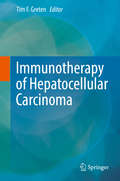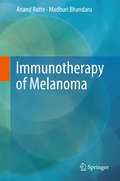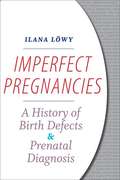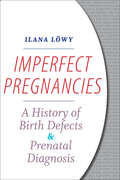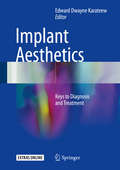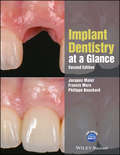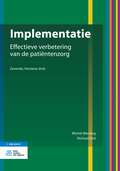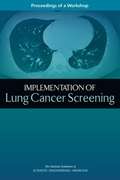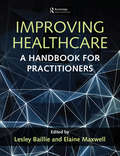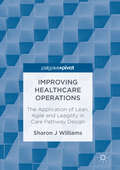- Table View
- List View
Imaging of Soft Tissue Tumors
by Filip M. Vanhoenacker Paul M. Parizel Jan L. GielenThis richly illustrated book, in an extensively revised new edition, provides a comprehensive survey of the role of medical imaging studies in the detection, staging, grading, tissue characterization, and post-treatment follow-up of soft tissue tumors. The indications for and relative merits of various imaging modalities are fully described, with particular emphasis on the role of advanced MRI techniques that can improve diagnostic accuracy and evaluation of treatment response. The most recent version of the WHO Classification of Soft Tissue Tumors is introduced, and individual chapters are devoted to imaging of each of the tumor groups in that classification as well as other soft tissue masses. Numerous new illustrations of both common and rare tumors are included, providing a rich pictorial database of soft tissue masses. In addition, imaging findings are correlated with clinical, epidemiologic, and histologic data. Imaging of Soft Tissue Tumors will be of value in daily practice not only for radiologists but also for orthopedic surgeons, oncologists, and pathologists.
Imaging of the Cardiovascular System, Thorax, and Abdomen
by Luca SabaMagnetic resonance imaging (MRI) is a technique used in biomedical imaging and radiology to visualize internal structures of the body. Because MRI provides excellent contrast between different soft tissues, the technique is especially useful for diagnostic imaging of the brain, muscles, and heart. <P><P>In the past 20 years, MRI technology has improved significantly with the introduction of systems up to 7 Tesla (7 T) and with the development of numerous post-processing algorithms such as diffusion tensor imaging (DTI), functional MRI (fMRI), and spectroscopic imaging. From these developments, the diagnostic potentialities of MRI have improved impressively with an exceptional spatial resolution and the possibility of analyzing the morphology and function of several kinds of pathology. <P><P>Given these exciting developments, the Magnetic Resonance Imaging Handbook: Imaging of the Cardiovascular System, Thorax, and Abdomen is a timely addition to the growing body of literature in the field. Offering comprehensive coverage of cutting-edge imaging modalities, this book: <Li>Discusses MRI of the heart, blood vessels, lungs, breasts, diaphragm, liver, gallbladder, spleen, pancreas, adrenal glands, and gastrointestinal tract <Li>Explains how MRI can be used in vascular, posttraumatic, postsurgical, and computer-aided diagnostic (CAD) applications <Li>Highlights each organ’s anatomy and pathological processes with high-quality images <Li>Examines the protocols and potentialities of advanced MRI scanners such as 7 T systems <Li>Includes extensive references at the end of each chapter to enhance further study <P><P>Thus, the Magnetic Resonance Imaging Handbook: Imaging of the Cardiovascular System, Thorax, and Abdomen provides radiologists and imaging specialists with a valuable, state-of-the-art reference on MRI.
Immune Infertility
by Walter K.H. Krause Rajesh K. NazThis book offers comprehensive coverage of both basic and clinical aspects of immune reactions responsible for infertility. It has four sections focusing on Sperm antigens, Antisperm antibodies (ASAs), Clinical impact of ASAs, and Immune contraception, and include contributions from leading experts in these fields. This new edition of the book offers a comprehensive update that reflects the very significant advances in reproductive immunology that have been achieved over the past five years, especially related to the sperm proteome, sperm-egg binding/fusion proteins, gene knockout studies, and immunocontraception. Reproductive immunology continues to be a fast-growing discipline in which new knowledge is emerging almost every day. Immune Infertility is a model source of vital and reliable information on the latest scientific developments in the field. It will be of value for clinicians, scientists, students, residents, and fellows working in reproductive biology, obstetrics and gynecology, and urology.
The Immune Response to Implanted Materials and Devices
by Bruna CorradettiThis book provides a comprehensive overview of the cascade of events activated in the body following the implant of biomaterials and devices. It is one of the first books to shed light on the role of the host immune response on therapeutic efficacy, and reviews the state-of-the-art for both basic science and medical applications. The text examines advantages and disadvantages of the use of synthetic versus natural biomaterials. Particular emphasis is placed on the role of biomimicry in the development of smart strategies able to modulate infiltrating immune cells, thus reducing side effects (such as acute and chronic inflammation, fibrosis and/or implant rejection) and improving the therapeutic outcome (healing, tissue restoration). Current cutting-edge approaches in tissue engineering, regenerative medicine, and nanomedicine offer the latest insights into the role immunomodulation in improving tolerance during tissue transplant in the treatment of orthopaedic, pancreatic, and hepatic diseases. "Immune Response to Implanted Materials and Devices" is intended for an audience of graduate students and professional researchers in both academia and industry interested in the development of smart strategies, which are able to exploit the self-healing properties of the body and achieve functional tissue restoration.
The Immune Synapse
by Michael L. Dustin Cosima T. BaldariThis volume provides all the essential protocols that are currently used to study the immune synapse. Chapters in The Immune Synapse: Methods and Protocols cover methods for the study of the dynamics of immune synapse assembly, traffic at the immune synapse, new high resolution imaging, biophysical and computational methods for the study of the immune synapse, effector immune synapses, B cell, NK and mast cell immune synapses, and immune interactions in vivo. Written in the highly successful Methods in Molecular Biology series format, chapters include introductions to their respective topics, lists of the necessary materials and reagents, step-by-step, readily reproducible laboratory protocols, and tips on troubleshooting and avoiding known pitfalls. Authoritative and practical, The Immune Synapse: Methods and Protocols will be of interest to immunologists and, at a more general level, to cell biologists, biophysicists and computational biologists.
The Immune System Recovery Plan: A Doctor's 4-Step Program to Treat Autoimmune Disease
by Dr Susan Blum M.D., M.P.H"The Immune System Recovery Plan is the right book, at the right time, by the right person. We are witnessing a significant increase in autoimmune inflammatory diseases, which include more than 80 different diagnoses. Dr. Blum has done a magnificent job helping the reader to understand how this family of inflammatory disorders, including arthritis and fibromyalgia, can be managed with the diet and lifestyle program she developed in her practice. Her step-by-step approach is based on her considerable years of experience as a physician, and the emerging medical science that, for the first time, has developed an understanding of how genetics, lifestyle and nutrition play a role in origin of these disorders. The approach described in Dr. Blum's book represents the leading edge in the lifestyle management of chronic inflammatory disorders. It is a 'news to use' book that provides real assistance to those with inflammatory disorders who are looking for a clinically sensible approach to their problems." (Jeffrey Bland, Ph.D., FACN, President, Personalized Lifestyle Medicine Institute)The innovative four-step method in this book focuses on:Using food as medicineUnderstanding the stress connectionHealing your gut and digestive systemOptimizing liver functionEach of these sections includes an interactive workbook to help you determine and create your own personal treatment program. Also included are recipes for simple, easy-to-prepare dishes to jump-start the healing process.The Immune System Recovery Plan is a revolutionary way for people to balance their immune systems, transform their health, and live fuller, happier lives.
Immunity: Innate Immunity (Advances In Experimental Medicine And Biology Ser. #560)
by William E. PaulA leading figure in immunology takes readers inside the remarkably powerful human immune system.Winner of the CHOICE Outstanding Academic Title of the Choice ACRLThe immune system has incredible power to protect us from the ravages of infection. Boosted by vaccines, it can protect us from diseases such as measles. However, the power of the immune system is a double-edged sword: an overactive immune system can wreak havoc, destroying normal tissue and causing diseases such as type I diabetes, rheumatoid arthritis, and multiple sclerosis. The consequences of an impaired immune system, on the other hand, are all too evident in the agonies of AIDS.Packed with illustrations, stories from Dr. William E. Paul’s distinguished career, and fascinating accounts of scientific discovery, Immunity presents the three laws of the human immune system—universality, tolerance, and appropriateness—and explains how the system both protects and harms us. From the tale of how smallpox was overcome and the lessons of the Ebola epidemic to the hope that the immune system can be used to treat or prevent cancer, Dr. Paul argues that we must take advantage of cutting-edge technologies and promising new tools in immunological research.
Immunogenetics of Fungal Diseases
by Agostinho CarvalhoThis book provides up-to-date information on immunogenetics of fungal diseases in the context of primary and acquired immunodeficiencies. Different aspects of this emerging field are covered, including epidemiology of fungal diseases, innate and adaptive antifungal immunity, and the role of immunogenetics in defining susceptibility to fungal diseases in primary (CMC, CGD, etc. ) immunodeficiencies and hematologic patients. The available information will also be discussed in the scope of new biomarker discovery and development of immunotherapeutic approaches for personalized diagnostics and therapy. The book addresses Professors, researchers and advanced students of Medicine, Immunology, Microbiology and Genetics.
Immunohistochemistry in Diagnostic Dermatopathology
by Hoang Mai P.Rapid and cost-effective immunohistochemistry plays a crucial role in diagnostic pathology. However there are currently very few textbooks dedicated to its role, especially in diagnostic dermatopathology. This comprehensive volume provides a practical guide to the application of immunohistochemistry in dermatopathology and bridges the knowledge gap by updating readers with helpful diagnostic immunostains as well as recently available ones. Organized by lines of differentiation, each chapter includes a synopsis of applicable antibodies, pertinent immunohistochemical panels, summary tables outlining the staining patterns of the entities in the differential diagnosis, and case studies. The twelve chapters cover entities based on lineage including epithelial, melanocytic, lymphoid, adnexal and soft tissue. The role of immunohistochemistry as a screening test for underlying genetic syndromes, immunobullous diseases, detection of infectious agents and therapeutic purpose is also discussed in detail. This is an essential text for pathologists, dermatopathologists and residents in pathology and dermatology.
The Immunology of Cardiovascular Homeostasis and Pathology
by Susanne Sattler Teresa Kennedy-LydonCardiovascular immunology is a newly emerging research area, investigating the crosstalk between the cardiovascular and the immune system. This crosstalk is evident through (1) crucial immunological capacities and functions of cardiovascular cell types, including cardiomyocytes, fibroblasts, endothelial cells, pericytes and cardiac resident macrophages, (2) the impact of aberrant immune function on the development of cardiovascular disease such as atherosclerosis, direct and indirect immune-mediated heart disease and vasculitis, and (3) the crucial role of the immune system in cardiac repair and regeneration. The Immunology of Cardiovascular Homeostasis and Pathology covers all these aspects of cardiovascular immunology, starting with homeostatic immunological functions of traditional cardiovascular cell types, and moving then to the role of the immune system in cardiovascular pathology and to recent research into targeting the immune system to boost cardiac healing and regeneration.
Immunopathology in Toxicology and Drug Development
by George A. ParkerThis book provides a fundamental understanding of immunopathology and immunopathologic processes, with particular attention to nonclinical toxicology studies. Chapters provide organ system-based summaries of spontaneous pathology and common responses to xenobiotics. A companion volume, Immunopathology in Toxicology and Drug Development: Volume 1, Immunobiology, Investigative Techniques, and Special Studies, offers an overview of general immunobiology, cells of the immune system, signaling and effector molecules, and immunopathology assays. These informative and strategic books were created in response to the large segment of drug development that focuses on chronic diseases, many of which involve alterations to the immune system. Therapies that target these diseases commonly involve some form of immunomodulation. As a result, the two volumes of Immunopathology in Toxicology and Drug Development are critical texts for individuals involved in diverse aspects of drug development. Readers will acquire a thorough understanding of immunopathology for detection and accurate interpretation of pathologic effects of xenobiotics on the immune system.
Immunopathology in Toxicology and Drug Development
by George A. ParkerThis book provides a fundamental understanding of immunopathology and immunopathologic processes, with particular attention to nonclinical toxicology studies. Chapters provide an overview of general immunobiology, cells of the immune system, signaling and effector molecules, and immunopathology assays. A companion volume, Immunopathology in Toxicology and Drug Development: Volume 2, Organ Systems, offers summaries of organ-specific immunobiology and immunopathology as well as common responses to xenobiotics. These informative and strategic books were created in response to the large segment of drug development that focuses on chronic diseases, many of which involve alterations to the immune system. Therapies that target these diseases commonly involve some form of immunomodulation. As a result, the two volumes of Immunopathology in Toxicology and Drug Development are critical texts for individuals involved in diverse aspects of drug development. Readers will acquire a thorough understanding of immunopathology for detection and accurate interpretation of pathologic effects of xenobiotics on the immune system.
Immunopatient: The New Frontier of Curing Cancer
by Peter RooneyWhen an X-ray of a sore arm quickly leads to a diagnosis of Stage IV kidney cancer—one which would soon affect his bones, his lungs, lymph nodes, and brain—Peter Rooney’s life will never be the same. Faced with the prognosis of an incurable disease and armed only with the will to fight back, Immunopatient chronicles Peter’s desperate quest for hope and healing, and the experimental treatment that will give him a chance to strike back at his disease. Detailing both the medical breakthroughs that provided Peter with cutting-edge treatment and his inspirational quest to conquer both his fear and his illness through mindfulness and positive visualization, Immunopatient is a gripping memoir, one that offers new hope to cancer patients everywhere to never give up looking for answers. Peter’s story, both humble and human, showcases the heights of medical science and the depths of human endurance, proving that anything is possible as long as you keep moving forward.
Immunotherapy
by Aung Naing Joud HajjarIn the last decade, immunotherapy has revolutionized the practice of medicine in the field of oncology. This book, Immunotherapy, highlights the immunotherapeutic approaches currently in use and strategies to overcome the associated challenges. As comprehensive knowledge of basic immunology in the context of tumor biology is required to move further along the line of development in translational science, this book provides an overview of the cellular components of the immune system that interact with each other to provide a successful immune response. Immunotherapy offers promising antitumor activity across multiple cancer types as it does not attack the tumor but primarily revitalizes a suppressed immune system. It is beyond the scope of this book to discuss the immunotherapeutic approaches across the tumor board. However, the book features the role of immune-oncology in acute myeloid leukemia, non-small cell lung cancer, and sarcomas to showcase the recent advances in the management of cancer broadly classified as hematological malignancies, solid tumors, and tumors arising in the connective tissue. The book also discusses alternative formulations and combinatorial approaches to enhance the therapeutic index of these agents. As immunotherapeutic agents differ significantly from chemotherapeutic agents in response patterns and toxicity profiles, evaluating their safety and efficacy in clinical trials remains a challenge. In this book, we discuss the use of a variety of traditional and new immunotherapy criteria to evaluate response, their inadequacies, and clinical implications. The book also outlines how recent advances in medical imaging technology have the potential to provide high-dimensional data to improve decision support and individualize treatment selection and monitoring. Importantly, the book attempts to increase the awareness to immune related adverse events and the need for aggressive and judicious management of toxicities to improve treatment outcomes in patients on immunotherapy In short, this book provides a broad understanding of immunotherapy and ways to leverage the immune system to make inroads in the fight against cancer.
Immunotherapy (Advances in Experimental Medicine and Biology #995)
by Aung Naing and Joud HajjarIn the last decade, immunotherapy has revolutionized the practice of medicine in the field of oncology. This book, Immunotherapy, highlights the immunotherapeutic approaches currently in use and strategies to overcome the associated challenges. As comprehensive knowledge of basic immunology in the context of tumor biology is required to move further along the line of development in translational science, this book provides an overview of the cellular components of the immune system that interact with each other to provide a successful immune response.Immunotherapy offers promising antitumor activity across multiple cancer types as it does not attack the tumor but primarily revitalizes a suppressed immune system. It is beyond the scope of this book to discuss the immunotherapeutic approaches across the tumor board. However, the book features the role of immune-oncology in acute myeloid leukemia, non-small cell lung cancer, and sarcomas to showcase the recent advances in the management of cancer broadly classified as hematological malignancies, solid tumors, and tumors arising in the connective tissue. The book also discusses alternative formulations and combinatorial approaches to enhance the therapeutic index of these agents.As immunotherapeutic agents differ significantly from chemotherapeutic agents in response patterns and toxicity profiles, evaluating their safety and efficacy in clinical trials remains a challenge. In this book, we discuss the use of a variety of traditional and new immunotherapy criteria to evaluate response, their inadequacies, and clinical implications. The book also outlines how recent advances in medical imaging technology have the potential to provide high-dimensional data to improve decision support and individualize treatment selection and monitoring. Importantly, the book attempts to increase the awareness to immune related adverse events and the need for aggressive and judicious management of toxicities to improve treatment outcomes in patients on immunotherapy In short, this book provides a broad understanding of immunotherapy and ways to leverage the immune system to make inroads in the fight against cancer.
Immunotherapy of Hepatocellular Carcinoma
by Tim F. GretenIn this book we provide insights into liver – cancer and immunology. Experts in the field provide an overview over fundamental immunological questions in liver cancer and tumorimmunology, which form the base for immune based approaches in HCC, which gain increasing interest in the community due to first promising results obtained in early clinical trials. Hepatocellular carcinoma (HCC) is the third most common cause of cancer related death in the United States. Treatment options are limited. Viral hepatitis is one of the major risk factors for HCC, which represents a typical “inflammation-induced” cancer.Immune-based treatment approaches have revolutionized oncology in recent years. Various treatment strategies have received FDA approval including dendritic cell vaccination, for prostate cancer as well as immune checkpoint inhibition targeting the CTLA4 or the PD1/PDL1 axis in melanoma, lung, and kidney cancer. Additionally, cell based therapies (adoptive T cell therapy, CAR T cells and TCR transduced T cells) have demonstrated significant efficacy in patients with B cell malignancies and melanoma. Immune checkpoint inhibitors in particular have generated enormous excitement across the entire field of oncology, providing a significant benefit to a minority of patients.
Immunotherapy of Melanoma
by Anand Rotte Madhuri BhandaruMetastatic melanoma are introduced to the readers, giving details of the diagnosis, clinical symptoms, types and AJCC staging, followed by a discussion of problems in the treatment of melanoma and how immunotherapy provided the solution. Next an account of the immune system is given, describing its role in cancer prevention and discussing how immune check points are circumvented in cancer. Approved drugs are discussed together with their molecular mechanisms of action, response rates, survival benefits, pharmacokinetics and adverse effects. Finally this book discusses the most promising candidates from ongoing clinical trials and highlights challenges faced by immunotherapeutic drugs as well as strategies to overcome them. Metastatic melanoma is a deadly type of skin cancer, known for its resistance to conventional treatments. For decades, patients were managed with a handful of drugs that had minimal survival benefits. The scenario changed with the approval of inhibitors of BrafV600E and MEK, and monoclonal antibodies against CTLA4. While the kinase inhibitors were promising in the initial studies, they suffered with the development of lethal resistance. Anti-CTLA4 monoclonal antibodies (Ipilimumab) on the other hand provided long term survival benefits in responding patients and there were no reports of resistance. However, response rate for Ipilimumab was very low. Recently, monoclonal antibodies against PD-1 receptors (Nivolumab, Pembrolizumab) were approved by FDA for the treatment of melanoma, extending the hope for melanoma patients. This book provides detailed information on immunotherapeutic drugs for melanoma management - it describes melanoma, discusses issues in melanoma treatment and highlights the successes of immunotherapy in the treatment.
Imperfect Pregnancies: A History of Birth Defects and Prenatal Diagnosis
by Ilana Löwy<p>In the 1960s, thanks to the development of prenatal diagnosis, medicine found a new object of study: the living fetus. At first, prenatal testing was proposed only to women at a high risk of giving birth to an impaired child. But in the following decades, such testing has become routine. <p>In Imperfect Pregnancies, Ilana Löwy argues that the generalization of prenatal diagnosis has radically changed the experience of pregnancy for tens of millions of women worldwide. Although most women are reassured that their future child is developing well, others face a stressful period of waiting for results, uncertain prognosis, and difficult decisions. Löwy follows the rise of biomedical technologies that made prenatal diagnosis possible and investigates the institutional, sociocultural, economic, legal, and political consequences of their widespread diffusion. <p>Because prenatal diagnosis is linked to the contentious issue of selective termination of pregnancy for a fetal anomaly, debates on this topic have largely centered on the rejection of human imperfection and the notion that we are now perched on a slippery slope that will lead to new eugenics. Imperfect Pregnancies tells a more complicated story, emphasizing that there is no single standardized way to scrutinize the fetus, but there are a great number of historically conditioned and situated approaches. This book will interest students, scholars, health professionals, administrators, and activists interested in issues surrounding new medical technologies, screening, risk management, pregnancy, disability, and the history and social politics of women’s bodies.</p>
Imperfect Pregnancies: A History of Birth Defects and Prenatal Diagnosis
by Ilana LöwyHow has prenatal testing, once offered only for high-risk pregnancies, become standard medical care for pregnant women today?In the 1960s, thanks to the development of prenatal diagnosis, medicine found a new object of study: the living fetus. At first, prenatal testing was proposed only to women at a high risk of giving birth to an impaired child. But in the following decades, such testing has become routine. In Imperfect Pregnancies, Ilana Löwy argues that the generalization of prenatal diagnosis has radically changed the experience of pregnancy for tens of millions of women worldwide. Although most women are reassured that their future child is developing well, others face a stressful period of waiting for results, uncertain prognosis, and difficult decisions. Löwy follows the rise of biomedical technologies that made prenatal diagnosis possible and investigates the institutional, sociocultural, economic, legal, and political consequences of their widespread diffusion. Because prenatal diagnosis is linked to the contentious issue of selective termination of pregnancy for a fetal anomaly, debates on this topic have largely centered on the rejection of human imperfection and the notion that we are now perched on a slippery slope that will lead to new eugenics. Imperfect Pregnancies tells a more complicated story, emphasizing that there is no single standardized way to scrutinize the fetus, but there are a great number of historically conditioned and situated approaches. This book will interest students, scholars, health professionals, administrators, and activists interested in issues surrounding new medical technologies, screening, risk management, pregnancy, disability, and the history and social politics of women’s bodies.
Implant Aesthetics: Keys to Diagnosis and Treatment
by Edward Dwayne KarateewThis book, written by acknowledged experts with international reputations, provides clinicians with detailed guidelines on the nature of the ideal anterior dental implant and, more importantly, how the desired aesthetic outcome is to be achieved. It reflects the incredible paradigm shift that has taken place within implant dentistry during the past 5 years, with recognition of the importance of a 'crown down' approach to diagnosis, planning, and treatment, especially in the anterior zone. In order to ensure reproducibility and predictability of treatment outcomes, the fabrication of an aesthetic dental implant must follow a complex algorithm, which is reviewed in a stepwise approach. Sections are devoted to evaluation of the aesthetic implant patient, immediate implant placement, staged implant placement, and restoration. Readers will come to appreciate how the final emergence profile of the definitive restoration reflects the complex interplay of components below the visible smile zone. Helpful flow charts are included that will assist in optimal performance of the described procedures.
Implant Dentistry at a Glance (At a Glance (Dentistry) #60)
by Jacques Malet Francis Mora Philippe BouchardThe second edition of Implant Dentistry at a Glance, in the highly popular at a Glance series, provides an accessible, thoroughly revised and updated comprehensive introduction that covers all the essential sub-topics that comprise implant dentistry. Features an easy-to-use double-page spread, with text and corresponding images Expanded and updated throughout, with 13 new chapters and coverage of many advances Includes access to a companion website with self-assessment questions and illustrative case studies
Implementatie: Effectieve verbetering van de patiëntenzorg
by Richard Grol Michel WensingDit boek helpt zorgverleners, leidinggevenden, staffunctionarissen, beleidsmakers en onderzoekers om pati#65533;ntenzorg op een effectieve manier te verbeteren. Het geeft een praktische, stapsgewijze aanpak voor de implementatie van innovatie in de gezondheidszorg, die rekening houdt met de weerbarstigheid van de praktijk. In Implementatie ligt de nadruk op het verbeteren van het handelen van artsen, verpleegkundigen, paramedici, andere zorgverleners, en de teams waarin zij werken. De pati#65533;nt staat hierbij centraal. Deze geactualiseerde uitgave geeft een toegankelijk overzicht van het wetenschappelijk onderzoek op het gebied van implementatie. Het beantwoordt bijvoorbeeld de vraag hoe het komt dat veel waardevolle inzichten, hulpmiddelen, programma's en best practices de weg naar de praktijk niet vinden. En andersom hoe het kan dat er soms werkwijzen gebruikt worden waarvan is aangetoond dat ze geen meerwaarde hebben voor pati#65533;nten of burgers. Implementatie beschrijft vele concrete voorbeelden van verandertrajecten in Nederland en daarbuiten. Bij het boek horen digitale verrijkingen, zoals samenvattingen van de hoofdstukken en toetsen met multiplechoicevragen en stellingen.
Implementation of Lung Cancer Screening: Proceedings of a Workshop
by Engineering Medicine National Academies of SciencesThe public health burden from lung cancer is substantial: it is the second most commonly diagnosed cancer and the leading cause of cancer-related deaths in the United States. Given the individual and population health burden of lung cancer, especially when it is diagnosed at later stages, there has been a push to develop and implement screening strategies for early detection. However, many factors need to be considered for broad implementation of lung cancer screening in clinical practice. Effective implementation will entail understanding the balance of potential benefits and harms of lung cancer screening, defining and reaching eligible populations, addressing health disparities, and many more considerations. In recognition of the substantial challenges to developing effective lung cancer screening programs in clinical practice, the National Academies of Sciences, Engineering, and Medicine held a workshop in June 2016. At the workshop, experts described the current evidence base for lung cancer screening, the current challenges of implementation, and opportunities to overcome them. Workshop participants also explored capacity and access issues; best practices for screening programs; assessment of patient outcomes, quality, and value in lung cancer screening; and research needs that could improve implementation efforts. This publication summarizes the presentations and discussions from the workshop.
Improving Healthcare: A Handbook for Practitioners
by Lesley Baillie Elaine MaxwellGood intentions to do our best in healthcare are not enough. Healthcare professionals need to know how to close the gap between best evidence and practice, by understanding and applying quality improvement principles and processes. Improving Healthcare is a practical guide, providing healthcare staff with the knowledge and skills that enable them to implement, evaluate and disseminate a quality improvement project in their own workplace. With a comprehensive coverage, chapters cover the history, selection and application of quality improvement philosophies and methods in clinical healthcare at team, unit, organisational and system levels. The book also considers social processes of implementation as well as technical aspects of measuring and improving quality. As an essential guide for healthcare practitioners at any level who are new to service improvement, Improving Healthcare includes practical examples and case studies of healthcare improvements that illustrate the concepts discussed.
Improving Healthcare Operations
by Sharon J WilliamsThis book examines the design of two care pathways to establish how key principles associated with systems thinking, quality improvement, and supply chain management can improve the design of these services. 'Lean' has typically been the prominent approach when improving the design of healthcare systems and is often selected by healthcare professionals to standardize and improve the delivery of care. Previous literature shows there has been varying success in the application of 'Lean', the author presents a study which examines the benefits of introducing 'Agile' as an alternative and complementary approach. Improving Healthcare Operations explores when 'Lean' and 'Agile' are most applicable, and instances where a hybrid approach can be employed. Including empirical qualitative data collected from two care pathways, it intends to provide organizations with an alternative in order to produce the level and quality of care that is expected by patients.
